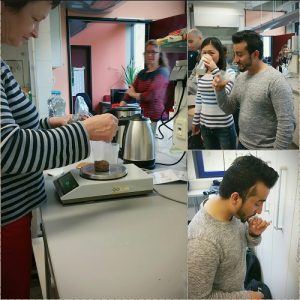In this post, first-year Ecotoxicology student and student blogger Adnan is telling you about the Toxicology Lab Course, which comprised two experiments: Ames test and caffeine clearance test.
The course was really exciting, as we were given the opportunity to test the mutagenic potential of a chemical of our choice in the Ames test, and we measured the metabolism and excretion of caffeine in our own bodies in the caffeine clearance test.
Our group decided to test dish wash liquid in the Ames test. This test is widely used to identify the substances that can cause gene mutations. It works as follows: On an agar plate, Salmonella typhimurium bacteria strains are spread that already have mutations and thus are unable to produce the amino acid histidine. Then, the test substance is applied. If this substance causes mutations, the capability of the bacteria strains to produce histidine and grow might be restored. That is why this test is also referred to as reversion assay or reverse mutation test. We made different dilutions of our sample of dish wash liquid and tested it in the Ames test. The number of revertant colonies grown in the dish wash liquid treatments were compared with the number of revertant colonies in the positive and negative controls. Thankfully, the results showed that our tested substance was not mutagenic 🙂
The second task of the Toxicology Lab Course was quite tough for all of us. We were asked to refrain from food and beverages containing caffeine, e.g. coffee, tea, chocolate and soft drinks. The idea was to get rid of the caffeine and its metabolites in our body before the start of the experiment. This was a really big challenge. We were also asked not to have breakfast on the day of the experiment as it could interfere with the results. We had to take either a full dose (20 g) or the half dose (10 g) of coffee. We took one saliva sample before drinking a coffee (0 h) and more saliva samples within the following 24 hours (0.5 h, 1 h, 2 h, 4 h, 8 h and 24 h). The first three saliva samples were taken in the lab, and we took Eppendorf tubes home with us to take the remaining ones. Getting the timing right led to funny situations: Some of us had to take samples on the way back home, others while grocery shopping. Moreover, spitting saliva in an Eppendorf tube was a big challenge for most of us as the tube opening is really small.
We brought back our Eppendorf sample tubes the next day and took our 24 h-sample again in the lab. The samples were diluted with methanol and the caffeine content was analyzed with HPLC-MS. The results showed that the caffeine elimination rates and thus the biotransformation potential varied greatly among students.
To conclude, we had quite some fun in the lab and both experiments provided us with interesting insights into toxicological standard assays.


